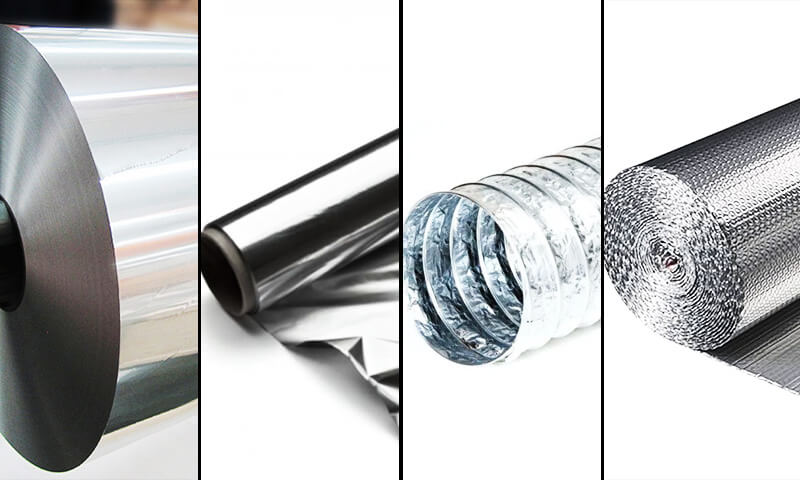1. INNGANGUR
Did you know that aluminum foil, a household essential for food wrapping, also plays a critical role in industries like aerospace, smíði, and medicine?
While it may seem like a simple product, aluminum foil is one of the most versatile and efficient materials used today.
From thermal insulation and food preservation to advanced electrical shielding, aluminum foil has transformed modern living.
Í þessu bloggi, we will explore the unique properties of aluminum foil, its manufacturing process, ýmsar tegundir þess, and its far-reaching applications across industries.
2. What is Aluminum Foil?
Skilgreining: Aluminum foil is an ultra-thin sheet of aluminum, with a thickness ranging from 0.006 mm til 0.2 mm, produced through precision rolling techniques.
Despite its thinness, it boasts impressive durability and flexibility.
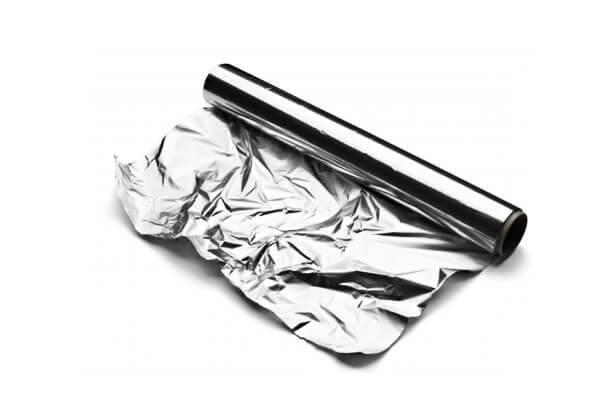
History:
- Early 1900s: Aluminum foil replaced tin foil, which was prone to tearing and imparting a metallic taste to food.
- 1910: The first industrial production of aluminum foil began in Switzerland.
- Í dag: Global production exceeds 3.5 million tons annually, with widespread usage in food packaging, einangrun, og rafeindatækni.
Aluminum foil has since become an irreplaceable material due to its lightweight nature and excellent protective qualities.
3. How Aluminum Foil is Made
The production of aluminum foil follows a precise sequence:
- Veltingur: Aluminum ingots are first cast into slabs and then rolled into thinner and thinner sheets.
Til dæmis, starting from an ingot about 15 cm thick, the final foil can be as thin as 0.006mm. - Glitun: The rolled aluminum sheets undergo annealing, where they are heated and cooled under controlled conditions to enhance flexibility and workability.
This process can increase the elongation by up to 40%. - Klára: During the final rolling stages, one side of the foil is polished to achieve a shiny surface, while the other remains matte.
This difference in finish serves practical purposes, such as identifying sides when wrapping or lining containers.
4. Key Properties of Aluminum Foil
Aluminum foil is a highly versatile material prized for its unique combination of properties that make it indispensable in various industries, from food packaging to aerospace.
Below are the key properties of aluminum foil that contribute to its wide range of applications:
Lightweight and Flexible
- Aluminum foil is incredibly lightweight, with a density of 2.7 g/cm³, making it easy to handle, transport, and shape.
- Its exceptional flexibility allows it to be molded into various forms without breaking, making it ideal for wrapping, folding, and shaping around objects.
- Dæmi: In food packaging, aluminum foil can tightly wrap items of different sizes and shapes with ease.
Excellent Barrier Protection
- The Aluminum foil acts as a 100% hindrun against light, súrefni, raka, odors, bacteria, and other contaminants.
- This impermeability makes it the material of choice for preserving food, Lyfjafyrirtæki, and sensitive industrial products.
- It prevents spoilage, extends shelf life, and protects delicate contents.
- Dæmi: Pharmaceutical blister packs rely on aluminum foil to keep medicines sterile and free from contamination.
Hár hitaleiðni
- Aluminum foil has excellent thermal conductivity, transferring heat efficiently and evenly.
- This property makes it ideal for cooking, grilling, Og freezing Forrit, as well as for use in HVAC kerfi for insulation.
- Dæmi: Aluminum foil is commonly used to line baking trays or to wrap food during roasting, ensuring even heat distribution.
Endurspeglun
- The shiny side of aluminum foil reflects up to 98% of radiant heat and light, making it highly effective for insulation and energy-saving applications.
- Það er mikið notað í byggingu, bifreiðar, and aerospace industries to reduce energy loss and protect materials.
- Dæmi: Reflective aluminum foil is applied in roof insulation to regulate indoor temperatures and reduce energy consumption.
Non-Toxic and Food-Safe
- Aluminum foil is non-toxic, lyktarlaust, and chemically stable, ensuring it is safe for food contact.
- It does not alter the taste or smell of food, which is why it is widely used for wrapping, grilling, and freezing food items.
- Dæmi: Aluminum foil is used to pack perishable foods like meats, cheeses, and baked goods for safe transportation and storage.
Durability and Strength
- Despite being thin, aluminum foil has a high strength-to-weight ratio and resists tearing and puncturing during normal use.
- Its strength ensures that it can withstand mechanical pressure during packaging, flutningur, or cooking.
- Dæmi: Heavy-duty aluminum foil is used to package industrial products or for outdoor cooking where additional strength is required.
Tæringarþol
- Aluminum foil naturally forms a thin oxíð lag on its surface, which protects it from corrosion caused by moisture, lofti, and many chemicals.
- This corrosion resistance extends the foil’s lifespan and makes it suitable for outdoor and industrial applications.
- Dæmi: In marine or industrial environments, aluminum foil serves as a protective layer to resist harsh conditions.
Recyclability and Eco-Friendliness
- Aluminum foil is 100% endurvinnanlegt without any loss in quality, making it a sustainable material choice.
- Recycling aluminum saves up to 95% of the energy required to produce primary aluminum, significantly reducing carbon emissions.
- Dæmi: Yfir 75% of all aluminum ever produced is still in use today due to its high recyclability.
Yfirlit töflu: Key Properties of Aluminum Foil
| Eign | Lýsing | Forrit |
|---|---|---|
| Létt & Flexible | Easy to mold and transport due to low density. | Food packaging, einangrun, wrapping. |
| Barrier Protection | Completely blocks light, raka, og mengunarefni. | Lyfjafyrirtæki, food storage. |
| Hitaleiðni | Transfers heat efficiently for cooking and insulation. | Grilling, baking, HVAC kerfi. |
| Endurspeglun | Endurspeglar allt að 98% of heat and light. | Smíði, orkunýtingu. |
| Non-Toxic and Food-Safe | Safe for food contact without altering taste or smell. | Food wrapping, cooking. |
| Varanleiki | High strength-to-weight ratio and tear resistance. | Outdoor cooking, industrial packaging. |
| Tæringarþol | The oxide layer protects against rust and chemicals. | Marine, industrial environments. |
| Endurvinnsla | Fully recyclable and energy-efficient. | Eco-friendly packaging solutions. |
5. Types of Aluminum Foil
Aluminum foil comes in various types, each tailored for specific applications or to meet particular performance criteria.
Here are some of the common types of aluminum foil:
Standard Household Foil:
- Þykkt: Venjulega er frá 0.016 mm til 0.024 mm (16 til 24 míkron).
- Nota: Designed for everyday household uses like wrapping food, covering dishes during cooking, or lining baking trays. It’s often referred to as kitchen or cooking foil.
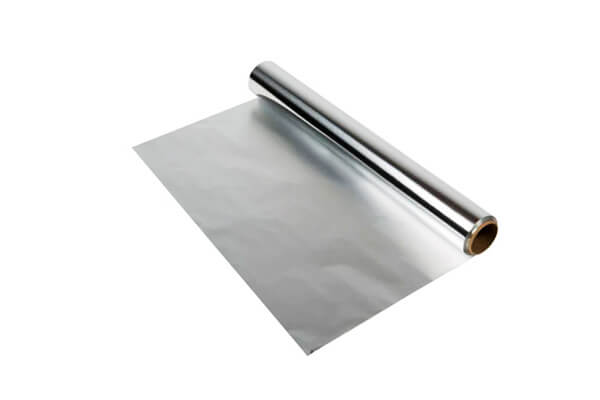
Heavy Duty Foil:
- Þykkt: Thicker than standard foil, oft í kring 0.03 mm (30 míkron) eða meira.
- Nota: Ideal for heavy-duty applications like grilling, and roasting, or when a stronger, more durable foil is needed to handle tougher jobs or higher temperatures.
Extra Heavy Duty Foil:
- Þykkt: Even thicker than heavy-duty foil, sometimes up to 0.04 mm (40 míkron) eða meira.
- Nota: Used for industrial or commercial purposes where maximum strength and durability are required, like in construction, einangrun, or heavy-duty packaging.
Laminated Foil:
- Samsetning: Aluminum foil bonded to other materials like paper, plast, or another layer of foil.
- Nota: Often used for packaging applications where additional properties like printability, tear resistance, or heat sealability are needed.
Examples include blister packs for pharmaceuticals, matarumbúðir, and insulation materials.
Colored or Printed Foil:
- Frama: Available in different colors or with printed designs.
- Nota: Used for decorative purposes, gift wrapping, arts and crafts, or for branding in food packaging.
Embossed Foil:
- Surface: Features a textured or patterned surface.
- Nota: Provides a decorative appearance, increases surface area for better heat transfer in cooking applications, or adds grip in packaging.
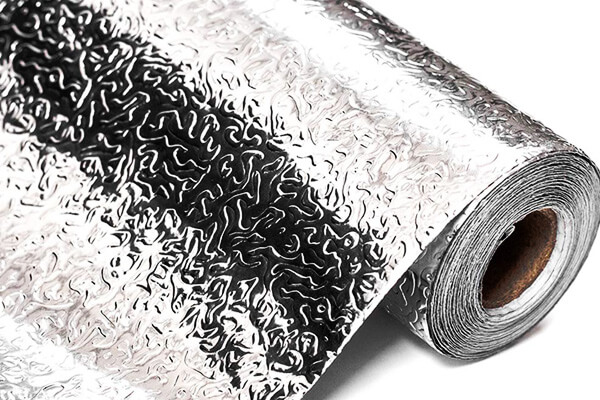
Insulation Foil:
- Uppbygging: Often laminated with other materials like polyethylene bubble or foam for enhanced insulation properties.
- Nota: Used in building insulation, HVAC kerfi, or for wrapping pipes and ducts to reflect heat.
Pharmaceutical Foil:
- Eignir: Typically very thin, oft í kring 0.01 mm (10 míkron), and might be coated or laminated for specific pharmaceutical packaging needs.
- Nota: For blister packs, to protect against moisture, súrefni, and light, ensuring the integrity of medications.

Cigarette Foil:
- Specifications: Þunnt, oft í kring 0.006 mm (6 míkron), and might have special coatings or treatments for tobacco packaging.
- Nota: To wrap individual cigarette packs, providing a barrier against moisture and preserving flavor.
Capacitor Foil:
- Purity: High-purity aluminum to ensure good electrical properties.
- Nota: For the construction of electrolytic capacitors in electronic devices.
Foil for Electronics:
- Eignir: Can be very thin and often treated or coated to meet specific electrical or thermal conductivity requirements.
- Nota: Used in heat sinks, electronic shielding, and as a base material in printed circuit boards (PCB).
Foil for Lidding:
- Hönnun: Often heat-sealable and can be easily peeled or permanently sealed.
- Nota: Used as a lid for yogurt pots, ready meals, and other food containers, providing an airtight seal.
Aluminum Foil Tapes:
- Smíði: Aluminum foil with an adhesive backing.
- Nota: For sealing joints and seams in ductwork, for HVAC applications, and as a heat shield in various industrial applications.
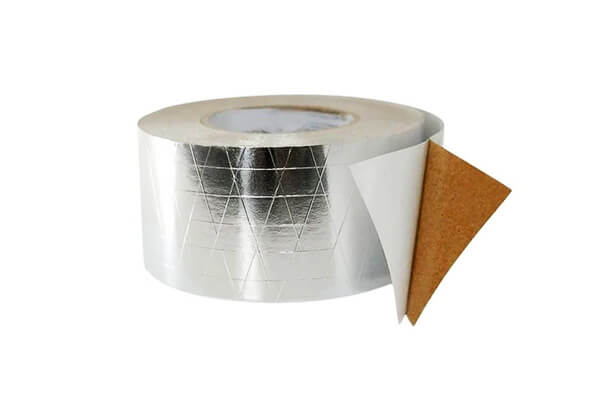
Aluminum Foil Containers:
- Form: Pre-formed aluminum containers or trays.
- Nota: For takeout food, baking, cooking, and serving food, offering convenience and disposability.
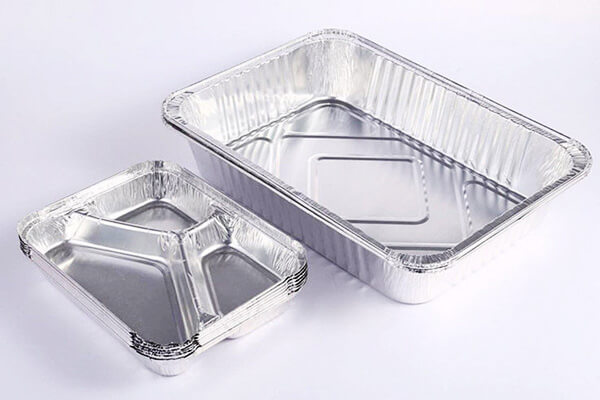
Foil for Automotive:
- Forrit: Used in car manufacturing for heat shields, einangrun, and as a component in catalytic converters.
6. Common Applications of Aluminum Foil
Aluminum foil finds extensive use across a wide range of industries and everyday applications due to its unique combination of properties,
including lightweight, Sveigjanleiki, hitaleiðni, barrier protection, endurskin, og endurvinnanleika.
Below are some common applications that highlight the versatility of this material:
Food Packaging and Storage
Aluminum foil plays a crucial role in preserving food quality and safety:
- Wrapping Leftovers: By wrapping leftovers tightly, aluminum foil prevents air and moisture from reaching the food, thus extending shelf life and maintaining freshness.
- Aluminum Foil Containers: These containers are widely used for takeout orders and ready-to-eat meals.
They offer excellent heat retention and can be directly placed in ovens or microwaves for reheating. - Baking and Grilling: Foil is commonly used to line baking sheets and grill trays, reducing cleanup time and protecting surfaces from spills and stains.
It also allows for easy portion control by creating individual cooking packets. - Freezing: When used to wrap foods before freezing, aluminum foil acts as an effective barrier against freezer burn and contamination,
ensuring that the food retains its flavor and texture.

Kitchen Use
In the kitchen, aluminum foil offers convenience and efficiency:
- Cooking: The thermal conductivity of aluminum foil makes it ideal for grilling, roasting, and baking.
Using foil can reduce cooking time by up to 20%, while also helping to evenly distribute heat and retain moisture in foods. - Lining Pans and Trays: Lining baking pans, grill trays, and oven racks with foil simplifies cleanup and protects these items from damage caused by spills and burns.
- Food Presentation: Foil can be shaped into decorative forms or used to create professional-looking finishes on dishes, enhancing the dining experience.
Iðnaðarforrit
The industrial sector leverages the robustness and protective qualities of aluminum foil:
- Building Insulation: Í smíði, aluminum foil serves as an efficient insulating material in roofing and HVAC systems.
Reflective insulation made from aluminum can reduce energy consumption by up to 30% by reflecting radiant heat away from buildings. - Electrical Shielding: Due to its conductivity and flexibility, aluminum foil is used in electrical cables and circuits to shield against electromagnetic interference (EMI) and radio-frequency interference (RFI),
ensuring the reliable performance of electronic devices. - Automotive and Aerospace: Lightweight yet strong, aluminum foil provides thermal insulation for spacecraft and vehicles.
Its ability to withstand extreme temperatures and its low weight contributes to improved fuel efficiency and operational reliability.
Medical and Pharmaceutical Use
In healthcare, aluminum foil ensures the integrity and safety of medical products:
- Blister Packs: Medications such as tablets and capsules are often packaged in aluminum blister packs.
These packs provide a barrier against moisture, light, and air, ensuring that the medication remains stable and potent until use. - Sterile Wraps: Medical instruments are wrapped in sterilized aluminum foil to maintain sterility during transport and storage.
This practice minimizes the risk of contamination and ensures patient safety.
Household and DIY Projects
At home, aluminum foil fosters creativity and practicality:
- Craftwork: Artists and hobbyists use aluminum foil for sculpting, jewelry making, and other craft projects. Its malleability allows for detailed shaping without breaking.
- Temporary Fixes: From patching small holes to reinforcing structures, aluminum foil can serve as a quick and effective solution for minor repairs around the house.
- Heat Reflectors: DIY enthusiasts often use aluminum foil to create homemade heat reflectors, improving heating efficiency in homes and conserving energy.
7. Advantages of Using Aluminum Foil
Aluminum foil offers a multitude of benefits that make it an invaluable material in both household and industrial settings.
Its unique combination of properties provides practical advantages that enhance efficiency, Öryggi, og sjálfbærni.
Let’s delve into the key advantages of using aluminum foil:
Durability and Strength
Despite its thinness, aluminum foil exhibits impressive strength and durability:
- Hátt styrk-til-þyngd hlutfall: Aluminum foil can support weights up to 50 times its mass, making it remarkably strong for its thickness.
This property is particularly beneficial in applications requiring lightweight yet robust materials. - Flexibility Without Losing Integrity: The material remains flexible while maintaining structural integrity, allowing it to be easily molded or shaped without tearing.
Umhverfisvænt
Aluminum foil stands out for its eco-friendly attributes:
- 100% Endurvinnanlegt: One of the most significant environmental advantages of aluminum foil is its infinite recyclability.
Recycling aluminum consumes 95% less energy compared to producing new aluminum from raw materials. - Sustainable Resource Utilization: Yfir 75% of all aluminum ever produced is still in use today due to recycling efforts.
Promoting recycling not only reduces waste but also conserves natural resources. - Minimal Waste Production: Properly recycling aluminum foil minimizes landfill waste and the associated environmental impact.
Hygienic and Safe
Aluminum foil ensures hygiene and safety in various applications:
- Non-Toxic Material: Safe for direct contact with food, aluminum foil does not impart any harmful substances.
It is widely used in food packaging and storage for this reason. - Resistant to Contaminants: The material forms an effective barrier against bacteria, olíur, og mengunarefni,
ensuring that packaged items remain clean and protected. - No Chemical Reactions: Aluminum does not react with most foods, preserving the taste and quality of stored items.
Orkunýting
The reflective properties of aluminum foil contribute to energy savings:
- Excellent Thermal Insulation: Reflecting up to 98% of radiant heat, aluminum foil significantly improves thermal insulation in buildings, vehicles, og tæki.
This reduces heating and cooling costs by up to 30%. - Heat Retention in Cooking: In kitchen applications, aluminum foil helps retain heat during cooking and reheating,
reducing energy consumption and improving cooking efficiency.
Hagkvæm
Using aluminum foil can lead to financial savings:
- Affordable Material: Compared to other materials with similar properties, aluminum foil is relatively inexpensive,
making it a cost-effective choice for both commercial and residential applications. - Long-Term Savings: The durability and reusability of aluminum foil mean that it can be used multiple times before recycling, leading to long-term cost reductions.
- Reduced Spoilage: By effectively preserving food and preventing freezer burn, aluminum foil minimizes food waste, contributing to overall savings.
Versatility and Convenience
Aluminum foil is incredibly versatile and convenient to use:
- Fjölbreytt forrit: From food packaging and storage to industrial insulation and medical packaging,
aluminum foil adapts to a wide array of uses across different industries. - Ease of Use: Its lightweight and flexible nature makes it easy to handle and apply, whether wrapping food, lining pans, or creating DIY projects.
- Storage-Friendly: The thinness of aluminum foil allows for compact storage, saving space in kitchens and workshops.
8. Tips for Choosing and Using Aluminum Foil
Here are some tips for choosing and effectively using aluminum foil:
Choosing Aluminum Foil:
- Þykkt:
-
- Standard Foil: Use for everyday tasks like wrapping food, covering dishes, or lining baking trays.
- Heavy Duty Foil: Choose for tougher jobs like grilling, roasting large items, or when you need extra durability.
- Extra Heavy Duty: For industrial applications or when maximum strength is required.
- Tegund úr álfelgur:
-
- If available, select foils with specific alloys for enhanced properties. Til dæmis, some might offer better heat resistance or corrosion protection.
- Width and Length:
-
- Consider the size of your needs; larger rolls are more economical for frequent users, but smaller rolls are easier to handle for occasional use.
- Non-Stick Coating:
-
- Some aluminum foils come with a non-stick coating, which can be beneficial for baking or cooking tasks where food might stick.
- Endurvinnsla:
-
- Ensure the foil you choose is recyclable or made from recycled material to be environmentally conscious.
- Vottanir:
-
- Look for foils that meet food safety standards or have certifications like FDA compliance for food contact.
Using Aluminum Foil:
- Wrapping Food:
-
- Tight Seal: Ensure a good seal when wrapping food to prevent air from getting in, which helps keep food fresh.
- Double Layer: Use a double layer for foods that might tear through a single layer or for extra insulation.
- Cooking and Baking:
-
- Shiny Side: There’s a debate about whether to use the shiny or dull side up.
The difference is minimal, but some believe the shiny side reflects heat better, so place it facing inward if you want to keep food moist. - Avoid Acidic Foods: Don’t cook highly acidic foods (like tomatoes or citrus) directly on aluminum foil at high temperatures to avoid aluminum leaching.
- High Heat: Use heavy-duty foil for high-heat cooking to prevent it from tearing or melting.
- Shiny Side: There’s a debate about whether to use the shiny or dull side up.
- Grilling:
-
- Grill Packs: Create foil packets for grilling smaller or delicate items to keep them moist and prevent them from falling through the grill grates.
- Heavy Duty: Use heavy-duty foil for direct grilling to withstand the heat and provide a non-stick surface.
- Insulation and Reflection:
-
- Shiny Side Out: When using foil for insulation, place the shiny side outward to reflect heat away from the item being insulated.
-
Lining Pans:
-
- Covering: Line baking pans or cookie sheets with foil for easy cleanup, but make sure the foil doesn’t touch the food directly if it’s acidic or very salty.
- Storing Leftovers:
-
- Refrigerator/Freezer: Wrap leftovers tightly to prevent freezer burn or cross-contamination of odors.
- Cleaning and Polishing:
-
- Scrubbing: Use crumpled foil as a scouring pad for cleaning surfaces or removing rust from metal objects.
- Fægja: Foil can be used to polish silverware when combined with baking soda and hot water.
- Crafts and Decorations:
-
- Art Projects: Use foil for its shiny appearance in crafts, or for creating reflective surfaces.
- Embossing: Emboss patterns into the foil for decorative purposes.
- Safety and Environmental Tips:
-
- Avoid Overuse: Use only as much foil as necessary to minimize waste.
- Recycle: Always recycle aluminum foil; it’s highly recyclable. Clean it if it has food residue, or ball it up to make it easier to recycle.
- Avoid Direct Contact with Electrical Appliances:
-
- Do not use aluminum foil in microwave ovens unless specifically designed for that purpose, as it can cause sparks and damage to the appliance.
- Preventing Rust:
-
- Use foil to cover metal surfaces exposed to moisture to prevent rust.
- Ironing:
-
- Place foil under the ironing board cover to reflect heat, reducing the time needed to iron clothes.
9. Commonly Used Aluminum Grades for Aluminum Foil
Aluminum foil is available in various grades, each offering unique properties suited to specific applications, including food packaging, industrial uses, og einangrun.
Below are the most commonly used aluminum grades for manufacturing aluminum foil:
1100 Álpappír
- Samsetning: 99.0% pure aluminum.
- Lykileiginleikar:
-
- Mikil tæringarþol.
- Excellent formability and workability.
- Low strength but great thermal and electrical conductivity.
- Forrit:
-
- Food and beverage packaging.
- Pharmaceutical foils.
- Decorative aluminum foils.
- Electrical insulation and heat exchangers.
1145 Álpappír
- Samsetning: 99.45% pure aluminum.
- Lykileiginleikar:
-
- Excellent corrosion resistance and reflectivity.
- Higher purity ensures superior barrier properties.
- Forrit:
-
- Laminated foils for food storage.
- Household foils and packaging.
- Insulation materials for HVAC systems.
1235 Álpappír
- Samsetning: 99.35% pure aluminum.
- Lykileiginleikar:
-
- Outstanding corrosion resistance and flexibility.
- Good barrier properties against moisture, light, and oxygen.
- Forrit:
-
- Flexible food packaging.
- Tobacco and chocolate wrapping.
- Pharmaceutical blister packs.
- Household aluminum foil.
3003 Álpappír
- Samsetning: Aluminum alloyed with manganese (um 1.2%).
- Lykileiginleikar:
-
- Better strength compared to pure aluminum grades.
- Framúrskarandi tæringarþol, particularly in moist environments.
- Retains high formability and workability.
- Forrit:
-
- Food containers and trays.
- Roofing insulation and HVAC systems.
- Industrial applications require moderate strength.
8011 Álpappír
- Samsetning: Aluminum alloyed with iron (0.6-1.0%) og sílikon (0.5-0.8%).
- Lykileiginleikar:
-
- Excellent corrosion resistance and mechanical strength.
- Superior barrier performance against moisture, lofti, and light.
- Highly suitable for coating and lamination.
- Forrit:
-
- Pharmaceutical packaging (T.d., blister packs).
- Food-grade foils for wrapping and baking.
- Beverage can lids and bottle caps.
- Household aluminum foil rolls.
8021 Álpappír
- Samsetning: Aluminum alloyed with iron (0.7-1.3%) og sílikon (0.5-0.9%).
- Lykileiginleikar:
-
- High strength and toughness.
- Superior barrier properties for air, light, and moisture.
- Ideal for deep-drawing and stretching processes.
- Forrit:
-
- Pharmaceutical cold-forming foil for blister packaging.
- Battery foil in electronics.
- Heavy-duty foil for industrial applications.
8079 Álpappír
- Samsetning: Aluminum alloyed with iron (0.6-1.0%) og sílikon (0.5-0.9%).
- Lykileiginleikar:
-
- Exceptional elongation and puncture resistance.
- Superior barrier properties.
- High flexibility for laminating and coating.
- Forrit:
-
- Flexible food packaging.
- Pharmaceutical packaging foils.
- Insulation foils for industrial applications.
Comparison Table of Common Aluminum Foil Grades
| Aluminum Grade | Purity (%) | Lykileiginleikar | Forrit |
|---|---|---|---|
| 1100 | 99.0% | Mikil tæringarþol, mjúkur | Food packaging, hitaskipti |
| 1145 | 99.45% | Superior barrier and reflectivity | Food and household foils, einangrun |
| 1235 | 99.35% | Sveigjanleiki, excellent barrier | Tobacco wrap, flexible food packaging |
| 3003 | Alloyed with Mn | Stronger than pure aluminum, varanlegt | Food trays, roofing insulation |
| 8011 | Alloyed with Fe & Og | Tæringarþol, styrkur | Pharma packaging, beverage lids |
| 8021 | Alloyed with Fe & Og | High toughness, barrier properties | Cold-forming foil, battery foil |
| 8079 | Alloyed with Fe & Og | Puncture resistance, Sveigjanleiki | Flexible food and pharma packaging |
10. Niðurstaða
Aluminum foil’s versatility, Ávinningur, and industry significance cannot be overstated.
From preserving food freshness to playing a vital role in advanced technologies, aluminum foil continues to be an indispensable material.
If you have any types of aluminum foil needs, Vinsamlegast ekki hika við Hafðu samband.

